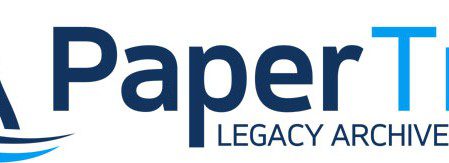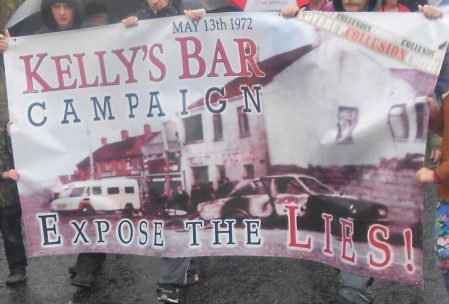Massacre at Kingsmill: The Secret British Army Files
The Kingsmill Massacre was one of the most vicious, nakedly sectarian attacks of the conflict.
A man waving a red light stopped a work van on a cold night and lonely Kingsmill road outside Whitecross, County Armagh.
Armed men with blackened faces, wearing camo-gear, surrounded it. They ordered the workers out of the van and told them to line up, face it, and place their hands on the side. They asked which one was the Catholic. Only one of the 12 men was. The rest were Protestant.
The workers thought that their Catholic workmate was about to be attacked so they did not give him up. The armed men asked again which one was the Catholic. No answer.
Regardless, one of the armed men gripped him out of the group. They knew which man was Catholic. They ordered him to run down the road.
The armed men told the remaining 11 men to tighten up along the side of the van. Then, they shot them. The victims crumpled onto the rain-soaked ground and any still alive groaned in pain. One of the armed men ordered the others to finish them off and they hit the victims with a second burst of gunfire.
Miraculously one man, Alan Black, survived even though he was hit around 19 times. 10 Protestant workers lay dead about him.
The Kingsmill Massacre of 5th January 1976 was perpetrated by a unit of the Irish Republican Army (IRA) using the cover name of South Armagh Republican Action Force (SARAF) as the IRA was officially on a truce.
The cover name had been used in a number of other sectarian atrocities including the indiscriminate attack on Tullyvallen Orange Hall near Newtownhamilton, Co. Armagh, on 1st September 1975 which claimed the lives of 5 Protestant civilians.
The IRA has yet to admit that its units used the cover name for the sectarian attacks.
The period of the so-called truce witnessed an increase of sectarian attacks by all combatants including the state, and the British intelligence services also used the period to infiltrate Republican and Loyalist paramilitary groups.
Just the day before two Catholic families, the Reaveys and O’Dowds, were attacked nearby by a Loyalist gang whose Ulster Volunteer Force members also included members of the British Army and RUC. They murdered 3 Reavey brothers and 2 O’Dowd brothers and their uncle.
The British Army’s Major C R N Meares at 3 Brigade Headquarters compiled an Intelligence Summary for his Commander the following day (5th January 1976). Even before the Kingsmill Massacre, his “REVIEW AND OUTLOOK” was bleak:
“In the centre of the 3 Infantry Brigade area a sectarian war is being waged which rose to a crescendo over the weekend… It is assessed that the very sectarian nature of the UVF’s provocation has put the PIRA in a quandary. The natural enemy is the SF [British Security Forces] but to maintain credibility retaliation is necessary against that part of the population which they one day believe will be part of a united Ireland. Such high flown sentiments may not preoccupy the thoughts of angry PIRA units in EAST TYRONE and ARMAGH but must affect the overall strategy of the PAC [Provisonal IRA Army Council]…
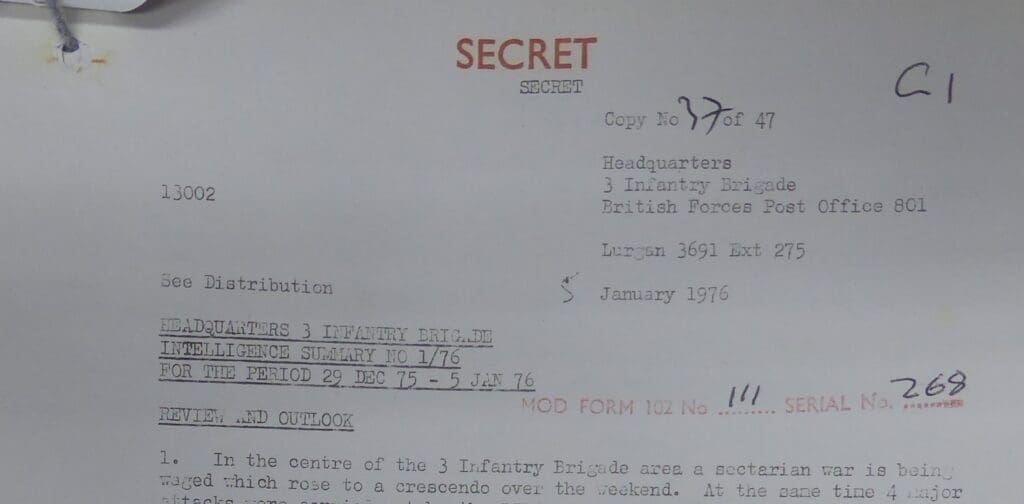

“The violent attacks by the UVF [are] likely to prompt an even harder reaction from the PIRA during the coming week. This will influence an already delicate situation in J Division [RUC area of management]. The main effort will be directed against suspect Protestant civilians and meeting places, although an opportunity to attack the SF will not be missed. The belief is that the MID-ULSTER UVF is more likely to hold its hand for a while, happy in the knowledge that they have created sufficient havoc…”

Into that mid-Ulster UVF mix, we now know its leading members were British Army, RUC, and paramilitaries run by British military intelligence.
Continue reading below...


Annex D in the same INTSUM dated 5th January 1976 recorded:
“This spate of sectarian conflict must be a problem for PAC who have other plans. On one hand they wield the threat of a new bombing campaign for further concessions from HMG. At the same time they must maintain the illusion of being the champions of the Catholic minority and can not afford to appear weak in the face of extreme Protestant challenges…”
“It must be expected that PAC will not restrain their units from normal response to sectarian attacks. The UVF etc will be delighted to continue the bloodletting they enjoy so much. PIRA attacks against the SF and commercial targets will continue at the present level until the sectarian troubles subside or PAC decide that a demonstration of power is called for on the political front..”
Annex D had opened:
“The tide of sectarian violence is now in full flood. The PIRA have been waving various flags while claiming a number of determined strikes against Protestant targets. The combined role [sic] of dead and injured has reached alarming proportions…”
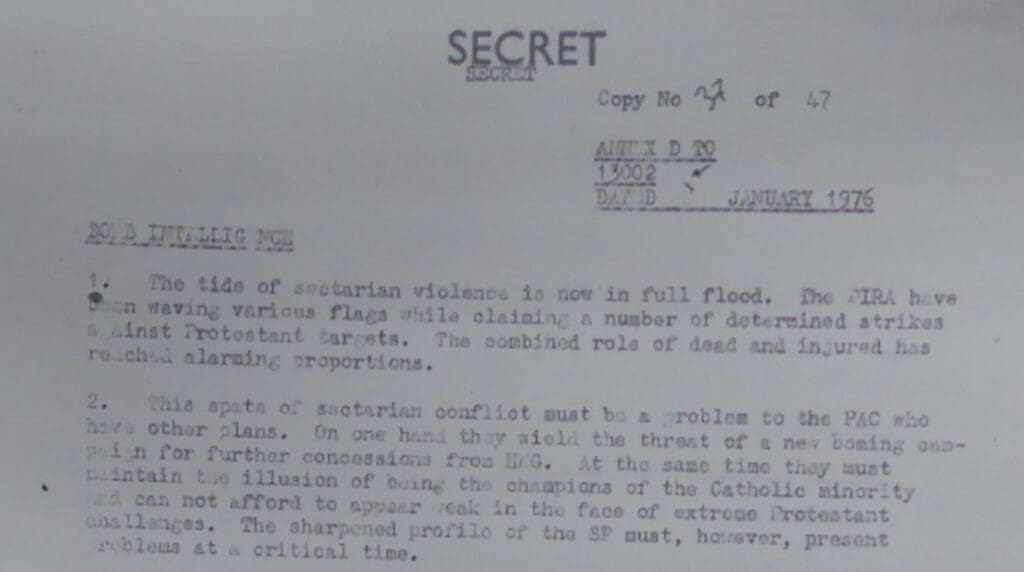

Worse was indeed to come and quicker than anticipated.
IRA units perpetrated the Kingsmill Massacre later that day under a flag of convenience, the South Armagh Republican Action Force, and January 1976 became another particularly dark month of the conflict when we again stared into the abyss of outright civil war.
Paper Trail has been working with families affected by these sectarian murders around this period and their legal teams.
The Kingsmill Massacre inquest concluded in April 2024 and it is reported that the families feel badly let down by the process and the lack of transparency from the Irish government particularly. They have called for a public inquiry.
All victims and survivors of the conflict deserve truth, justice, and acknowledgement.
The Secret Kingsmill Massacre Files
Over the years, Paper Trail discovered secret archives and accessed them for families via the Freedom of Information Act and protracted Public Interest Tests.
These files were given to the legal teams and/or families over the years and are now part of the public record in the National Archives, London.
They are part of the British Army’s 3 Brigade logs covering the area and month. Here is what these particular British Army files say about the terrible night of the Kingsmill Massacre.
1st Battalion of the Royal Scots Regiment (1 RS) reported to Brigade HQ at 1600 hrs (4pm):
“HIJACKED VAN
A RUC source has reported a BLUE [sic] BEDFORD VAN VRN [Vehicle Registration Number] [REDACTED] hijacked in Dundalk by an unknown number of men. The van is marked [REDACTED] and was hijacked at 1540 [340 pm]”
All units of British armed forces in the area were informed including 174 Provost Company 1st Regiment Royal Military Police and British Military Intelligence.

The Bedford was dark green with the registration DIA 8287 and bore the name of the company that owned it on the side. It was hijacked across the border on the Ballymascanlon Road near Dundalk. The hijack victims had to walk to a petrol station to use the phone and inform Gardaí. Gardaí then informed RUC as was usual practice.
If it was stolen around 3pm, that still leaves a lot of time between the two points – the scene of the hijacking and the massacre.
The distance between Ballymascanlon and Kingmill/Tullywinny Roads is about 17 miles which is around 20 minutes travel time. The hijacked van had to cross the border and navigate away from any expected vehicle checkpoints around Newry and Bessbrook. There were also British Army observation posts (OPs) in the area of Whitecross following the Reavey killings the night before.
Indeed, the work van was sighted by witnesses at various times before and after it was used in the Kingsmill Massacre at around 1735 hours (535 pm).
In these British Army logs, 1 RS actually reported at 1645 (4:35pm) that the hijacked van was seen 10 minutes before:
“… was reported as seen by RUC Newry in NEWRY at 1635 hours.”

Then, at 1750 hours (5:50 pm), the horror:
“1 RS DEAD MEN ON ROAD REPORTED”
There then follow a flurry of reports as you would expect in these files after a serious incident.
“RUC have reported that there are possibly 6 -7 dead men on the road at GR [Grid Reference] 014307, also a mini-bus in the same area.”
“1802 hrs. [6:02 pm]. OPs in the area have heard nothing, but a hel [helicopter] is in the area now. Passing motorists have reported seeing a van that appears to have been attacked. Ambulances have been tasked to the area. The initial report was by 999 call RUC.”
“1815 hrs. RUC have confirmed that there are 10 people dead and the bodies are being moved now to Daisy Hill Hospital NEWRY.”
“1817 hrs. 2 cars thought to have been involved BLACK AUSTIN CAMBRIDGE [REDACTED] and also a RED HILLMAN AVENGER.”
“1832 hrs. The dead people are all Protestants, 1 RC [Roman Catholic] also involved but not shot. They were a van load from GLENGARRY FACTORY, all locals from BESSBROOK.”
1855 hrs. Wpns [weapons] involved believed to be Armalite and Garand. Empty cases are being collected by SF [Security Forces] on scene now. The men involved appear to have been taken out of the vehicle, line up and shot. It is now believed that one of the 10 [sic] may only be wounded.”
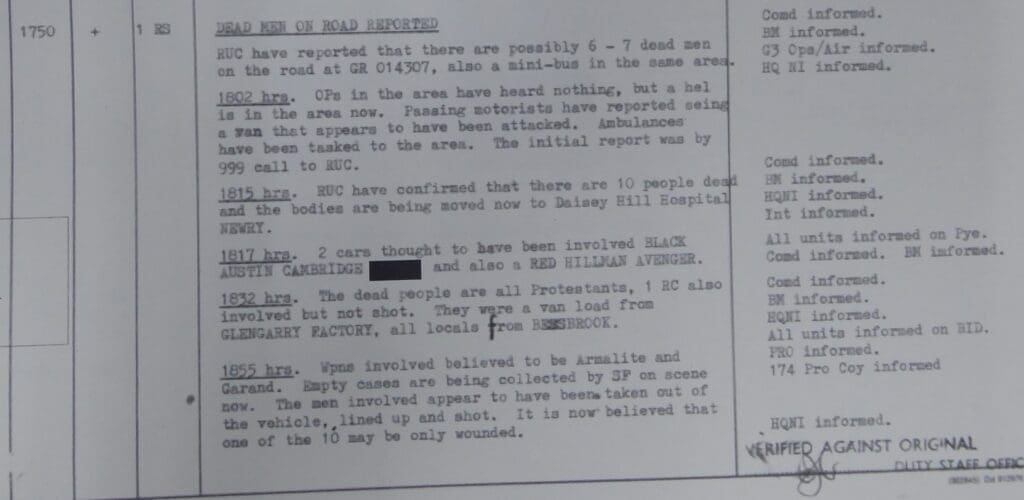
In a cruel twist, one of the first RUC officers on the scene was involved in the murder of the O’Dowd family the night before.
Belfast Telegraph reported on the 30th anniversary of the Kingsmill Massacre that RUC Special Patrol Group member William McCaughey said:
“When we arrived it was utter carnage. Men were lying two or three together. Blood was flowing, mixed with water from the rain. There was a thick thorn hedge with two men stuck in it. They were that desperate to escape they’d tried to run through the hedge. They had to be pulled from it.”
“When I got home, I noticed the bottom of my trousers – big, heavy police trousers, were soaked. I squeezed them out on the kitchen floor and I think there was as much blood as water. I had a lot of bad experiences but that was the worst, certainly in terms of human suffering.”
McCaughey later served time not for the O’Dowd murders the night before, but for another sectarian murder in 1977.
The British Army logs then recorded orders to All Units.
“Maximum no [number] of P CHECKS, house searches. Lists to be made out in consultation with RUC in reaction to this serious incident… All units required to produce maximum turnout.”
At 1930 hours [7:30 pm], British military intelligence was given the names of all of the victims including the Catholic colleague they protected. Intell reported back that there were:
“No traces on any of these men.”
That is, none of the victims were known to Intelligence for criminal or paramilitary activity.
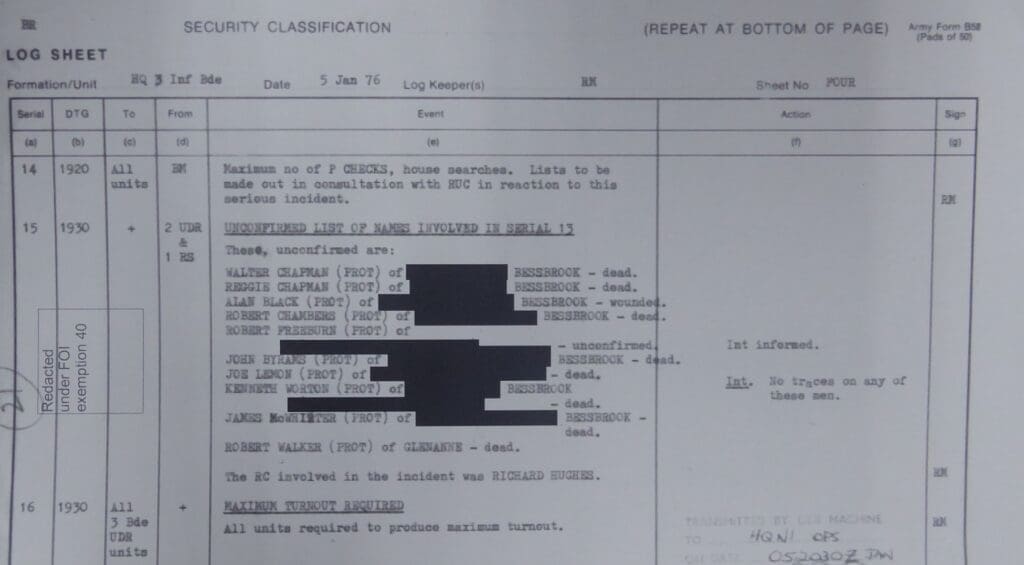
An unredacted British Military Intelligence Summary (INTSUM) for the period 5 – 12 January 1976 records the Review and Outlook:
“1. The most serious sectarian incident that has occurred in the campaign within the Brigade area, took place at KINGSMILLS near WHITECROSS in the early evening of 5 Jan 76. It was the culmination of a weekend of retaliation and counter-retaliation. Ten Protestants were gunned down and one seriously injured. It would appear that a rogue ASU [Active Service Unit] based on DUNDALK was responsible. These men are thought to have been implicated in previous incidents at KILLEEN on 3 June 75, TULLYVALLEN orange hall on 1 Sep 75 and the SF OP near H27 on 22 Nov 75. It is believed that the PAC [Provisonal IRA Army Council] were surprised and embarrassed by this incident; it did not fall within their strategy of gaining a declaration of intent by HMG to withdraw from the province. The extremist Protestants were probably surprised at the speed of retaliation. Ordinary people in the area were terrified. Another 20 Catholic deaths in retaliation were freely talked about, but perhaps surprisingly the farther people were removed from the scene of the massacre, the stronger was the feeling that it had not happened in their area and was therefore and not their problem.”

Annex A of the report focuses on “REPUBLICAN ACTIVITIES” for the period. It records:
“In the early evening of 5 Jan 1976 a minibus containing a mainly Protestant workforce was on its way from GLENANNE Mills, GLENANNE to BESSBROOK, when it was flagged down by gunmen at KINGSMILLS, 1 km East of WHITECROSS. The gunmen extracted the only Catholic, told him to hurry on and then gunned down the remaining Protestants causing 10 deaths and 1 VSI [very serious injury]. The following points are of particular interest:
- This act of retaliation was more prompt than expected. It may have taked PAC by surprise.
- A rogue ASU [Active Service Unit] based on DUNDALK was probably responsible. Judging by the forensic evidence the same ASU was responsible for the following incidents:
- 3 Jun 75 – KILLEEN Crossing murders
- 1 Sep 75 – TULLYVALLEN Orange Hall murders
- 22 Nov 75 – Shooting of 3 RRF OP [3rd Battalion Royal Regiment of Fusiliers Observation Post] at H 27 [BA ref. at Drumuckaval] [3 Fusiliers killed]
The first 2 incidents like the murders on 5 Jan were blatantly sectarian.”
The redacted annex then records a suspect linked to the attack who was allegedly ex-Officer Commanding of the North Louth ASU “who was thrown out by the PIRA but reinstated because of the support that he enjoyed.”
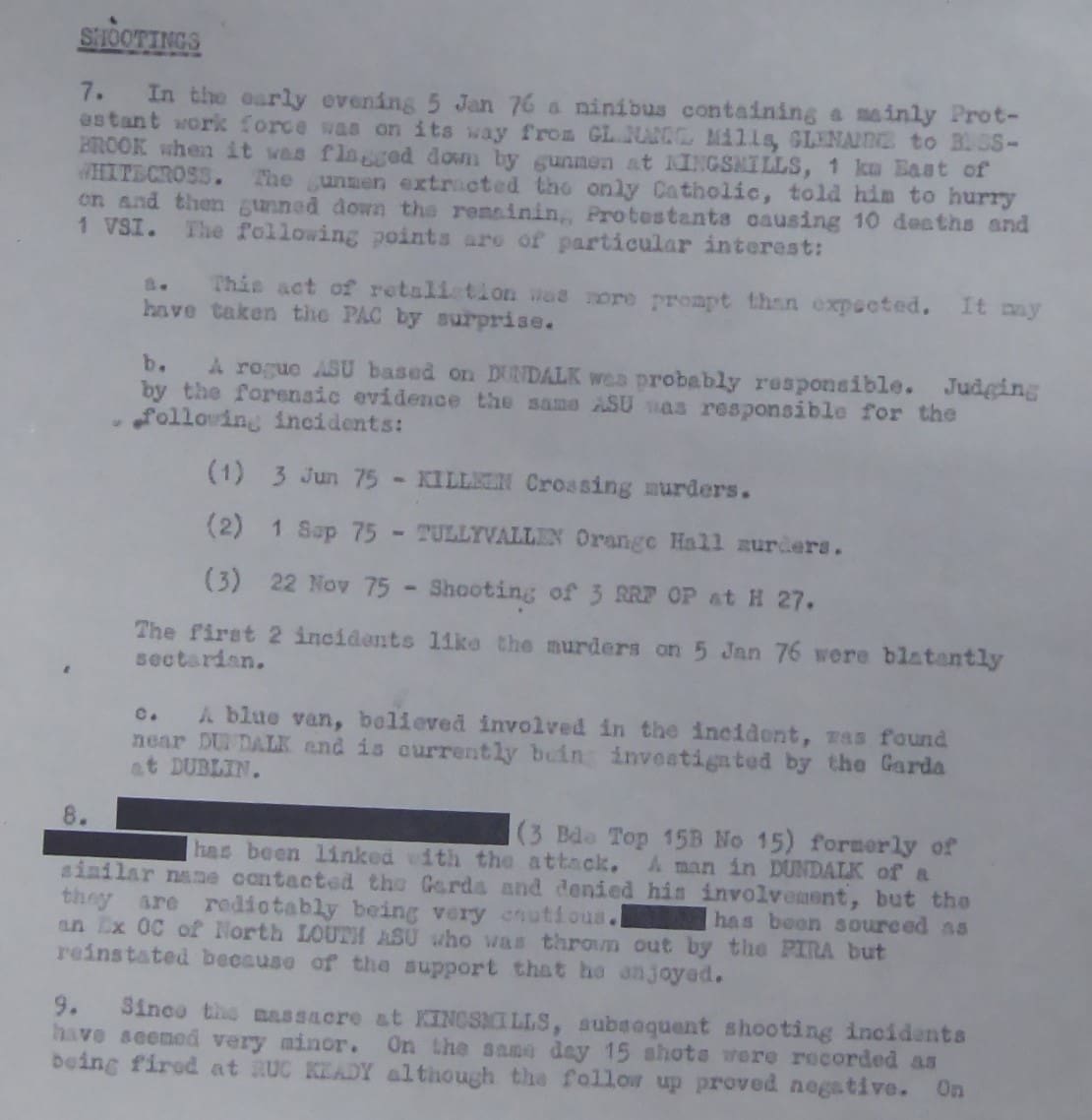
The Kingsmill families would contest the definition of “rogue” in these files as it implies that the unit was a breakaway and/or not under IRA command before, during, or after the attack. If there was a Republican splinter group that had used IRA weapons in sustained opposition to/contravention of IRA the ceasefire at the time, it would have expected retribution from the main body as was experienced during numerous schisms throughout the conflict. There were mounting internal pressures within the Republican movement at this time though too - caused in no small part by the facade of an ongoing truce.
The Coroner addressed this command and control point directly at Inquest:
“The Army Council of the IRA, in considerable disarray by January 1976, did not direct individual operations but dictated strategy. In April 1975 the orders of the Army Council allowed IRA units to take retaliatory and defensive actions. That created an exceptionally wide discretion. IRA units largely operated with autonomy. The dominant IRA figure in the Louth and South Armagh was a member of the Army Council and accordingly the actions of the IRA in that area effectively carried the authority of the Council. Kingsmill was not an operation undertaken by a rogue element, but an attack permitted by the Army Council’s order and carried out by the IRA.”
Later intelligence reports stated though that the attack was planned weeks before too. The deliberate targeting of these victims, knowledge of their route home, the pre-selection of the ambush area, and the resources required to carry out the attack (safe houses, vehicles, manpower, materiel, scouting, safe routes in and out, etc) would support that it was a carefully pre-planned sectarian attack.
As discussed, it also fitted a pattern of sectarian attacks carried out by both sides at the time. Even though these sectarian attacks continued afterward, arguably they could have been much worse and we may have descended into outright civil war.
McCaughey (and Weir) alleged that the UVF/RUC/British Army units that killed the O’Dowd and Reavey family members planned to attack a primary school and murder the children.
British military intelligence files also picked up the potential for worse outrages in the hours and days after the Kingsmill Massacre.
The British Military Intelligence report the week later dated 12th January recorded under “PROTESTANT EXTREMISTS REACTION TO EVENTS OVER 3 – 5 JAN”:
“A report whose reliability cannot be judged states that UVF members have reconnoitered a RC [Roman Catholic] church near RICHHILL, Co ARMAGH for a sectarian attack. This church has yet to be positively identified. In the PORTADOWN and LURGAN area a number of buses and minbuses carrying Catholics are believed to be the targets. The most dangerous threats are to site workers traveling between BANBRIDGE and NEWRY (passing the scene of the MIAMI Showband incident) and to workers at the MOY Chicken factory living at DERRYGONNELLY.”

Whether the workers there were informed is unknown but the British Army logs recorded on 6th January 1976:
“There are 4 RC Church services in Lurgan tonight.
St Peter’s Church, North St – 1830 [6:30 pm]+ 2000 [8:00 pm]
St Paul’s Church, Francis St – 1830 + 2000 1830 [6:30 pm]+ 2000 [8:00 pm]
The RUC have asked for protection.”

The British Army rushed extra troops in a Spearhead Battalion into the Armagh Murder Triangle and announced it was officially sending in the SAS (although SAS members were in the area throughout the conflict in different guises, roles and names (MRF, SRU, etc).
In Annex B of the above the British Army recorded:
“The spate of extremist Protestant activity culminating in the murders at WHITECROSS [Reavey family] and The Slopes near Bleary [O’Dowd family] on 4 Jan 76 has been followed by a comparative lull. As discussed in Annex A the PIRA reacted savagely at KINGSMILLS which led in turn to the arrival of the Spearhead Bn. Certainly the higher troop levels in Mid-ulster have been instrumental in causing the current lull, but important disagreements within the UVF itself are believed to be the prime cause.”
Unprecedented Prison Meeting
Annex C of the same British military report also records a flurry of high-level visits on 8th January with those in charge of the paramilitary groups in the Maze prison including David Morley (Officer Commanding PIRA) and [REDACTED], Seamus Clarke (OC Official IRA), Frank Gallagher (OC Irish Republican Socialist Party), James Craig (OC UDA) and Gusty Spence (OC UVF).
The names of those who visited them are redacted in these files but the visits were obviously important enough to be recorded together.

The same tranche of files discussed rumors of the differences and shifting power structures within the Provisional wing of the Republican movement.
"PIRA Leadership of the Maze
a. Rumour has it that David MORLEY has been deposed as OC 4 Bn [Officer Commanding 4th Battalion] Belfast Brigade PIRA by the 2IC [Second in Command] P MULVENNA, who is felt to be the real, if not titular, OC. Gusty SPENCE has said this is not true. However, the opposition to MORLEY is led by three ex-Belfast Bde PIRA, namely: Ivor BELL, Gerry ADAMS and Brendan HUGHES, the main point of contention being MORLEY's strict adherence to the policy of the Belfast Bde which is apparently to keep things quiet. Several compound leaders who supported MORLEY have since been deposed, consequently the only compound he effectively controls is his own, Compound 12. It would seem that the Belfast command are trying to appease the militants by fading MORLEY out and bringing in MULVENNA, whose reputation for toughness may temporarily hush the critics. In this respect it is interesting that MORLEY has applied for compassionate parole although it may be no more than to see his old father.
b. [REDACTED] a MORLEY supporter, has been deposed as OC of Compound 10 (C Coy) by [REDACTED] a supporter of ADAMS and BELL."
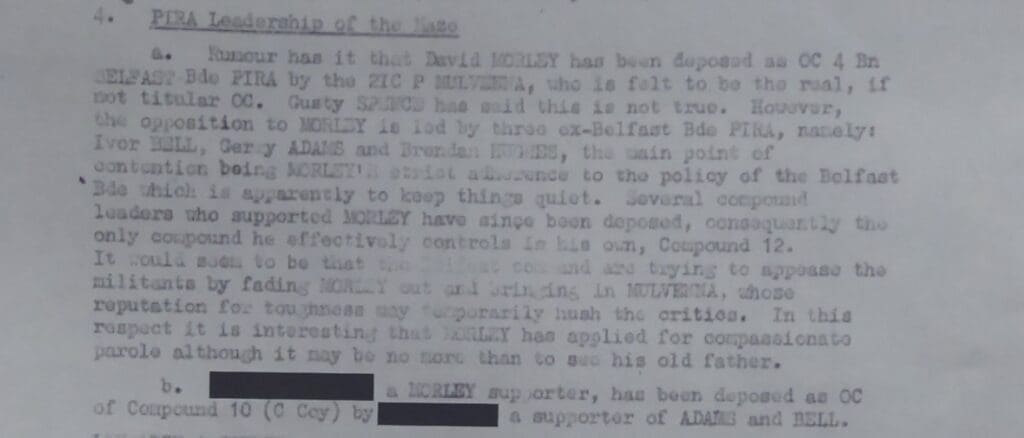
The British military intelligence report had recorded an "unprecedented" meeting though before these rumours of PIRA tensions:
“An unprecedented event occurred when, prompted by considerable anxiety resulting from the recent sectarian murders, the loyalist and republican leaders in HMP [Her Majesty’s Prison] Maze met in one room in the detainees hospital block on 9 January. The meetings of the previous day presumably arranged us the basis of these negotiations was that the random sectarian murders must stop and that the prisoners themselves must bring pressure to bear on their parent organizations in order to achieve this. A possible agenda for the meeting was found a copy of this is given below;
- Concrete proposals to stop a sectarianism.
- Followed by a declaration, jointly made, giving specific undertakings that sectarian killings will be eliminated.
- Alternatively, each individual organization issue a similar declaration, simultaneously, on a definite date to be named forthwith
- Lines of communication be set up between organizations for the purpose of quelling rumours or clarifying any misunderstandings that may arise
- That discussions be undertaken to attempt to arrive at solutions to our problems, (which established politicians have so far failed to do)
- A serious attempt be made to find a compromise between Protestant and Catholic working class, as the only way to avoid both Social and Economic disaster
- 15 – 30 minutes discussion on parole.
The major fear of the paramilitary organisations is that they will lose complete control due to the sectarian killings. It is believed that the status of “Combatants” was also discussed; whether for instance an off duty UDR. man or a reserve RUC man was a fair target; or Provisional Sinn Fein as well as PIRA. At this stage it is not known whether any firm conclusions were reached.”
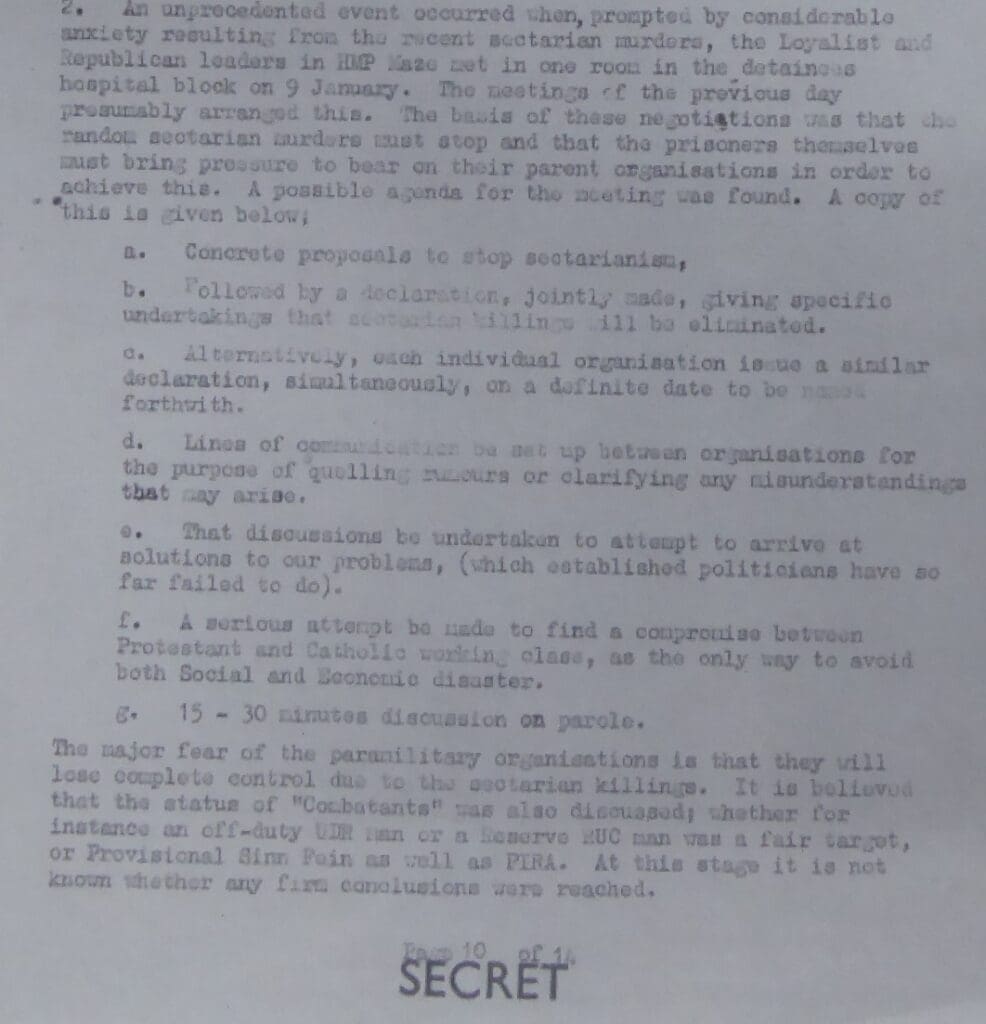
Outright civil war emanating from the Murder Triangle of Armagh may have been averted, but the sectarian killings continued.
Indeed, B Company 1 UVF enacted a copycat plan to attack a van-load of Catholic workers near Ligoniel in North Belfast just less than two weeks later on 22nd January. It was to be a re-run of the Kingsmill attack but this time it was thwarted due to the heroism of the one Protestant worker in the van.
John Morrow was driving and reversed at speed out of the ambush. He was shot and killed by the UVF attackers but not before he put distance between him and the attackers which allowed his Catholic workmates to escape out the back of the van. He saved the lives of 5 of his workmates but died at the scene.
Robert James Campbell served time for his murder as he was helped plan the attack. Campbell was the only person convicted of the McGurk’s Bar Massacre in 1971 which claimed the lives of 15 civilians including two children and this author's grandmother.
State Agents
The role of state agents throughout many of these killings in the Mid-Ulster area has not been properly ventilated due to the continual denial, delay, and legal obstruction of the British and Irish states.
In the past, Kingsmill survivor, Alan Black, queried the existence of British state agents working within the IRA unit that murdered their loved ones. The Coroner addressed this directly:
“[204] Some close to the Inquest have suggested that those responsible for Kingsmill were not subjected to criminal charges in order to protect an informant. Such an assertion is entirely without foundation in fact. It is unevidenced and unhelpful conspiracy theorizing. There was no evidence of anyone being allowed to continue in criminal ventures in order to protect informers.”
Nevertheless, the use of Public Interest Immunity certificates during the Inquest north of the border and closed procedures that barred the families and their legal representatives from hearing evidence south of the border has caused further hurt to the families and raised grave suspicions. The families remain upset that the inquest did not name the dead IRA suspects. Many had lost faith in the coronial inquest process too.
The families, supported by their advocates and local political leaders, have now demanded a public inquiry.
Inquests should allay rumour, fear and suspicion. A reading of the Coroner’s findings shows why the suspicions remain and the families deserve a full inquiry.
The 10 men murdered in the Kingsmill Massacre were:
Robert Chambers, 18; John Bryans, 46; Reginald Chapman, 29; Walter Chapman, 35; Robert Freeburn, 50; Joseph Lemmon, 46; John McConville, 20; James McWhirter, 58; Robert Walker, 46; and Kenneth Worton, 24
Related
Statement of solicitor, Barry O'Donnell KRW Law on the Kingsmill inquest verdict and its findings (link)


